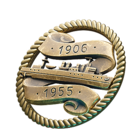Five Epochs of the Navy Collection
"The image of a ship has always had an aesthetic value that is incomparable to that of any other man-made creation. For centuries, people have been fascinated by the charming harmony of the majestic sailing ships that crossed the waters of our world. But in the 19th century, the Industrial Revolution spurred the pace of human life—wood and wind were replaced by metal and steam.
Ships embodied all the remarkable scientific and engineering achievements that drove the development of our civilization up until the beginning of the space era. The 20th century brought with it unprecedented and ruthless world wars, and it was only natural that warships took center stage in shipbuilding at the time. Yet, people never ceased to admire the order and symmetry of their features, as well as the complexity and deadly power of the weapons they carried."
The overall collection comprises five sub-collections. Each sub-collection grants 24 hours of Warships Premium Time. The reward for obtaining all 30 items is a permanent, attachable camouflage. Duplicates can be exchanged at a 1:1 ratio.
Contents
Sub-Collections
Early Dreadnought Era
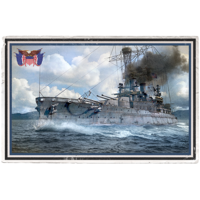
The U.S.A. commenced development of a battleship carrying main guns of the same caliber sooner than Great Britain. The assignment for designing a battleship with 305 mm main guns and great number of 76 mm secondary guns was issued in the autumn of 1903. But the construction of the first such ships, South Carolina and Michigan, significantly exceeded the allotted time, and the ships were commissioned only in 1910. Due to the water displacement limit set by Congress, for the first time in the world, four twin-gun main turrets were arranged according to a superfiring scheme in order to save space. That is why South Carolina could fire a broadside from the same number of guns as Dreadnought, which had two extra guns.
Due to financial limitations, the ship was propelled by steam engines rather than expensive turbines, which made the first American dreadnoughts the slowest-going warships—just 18 knots. This turned out to be their major drawback, one which forced them to cooperate with old-fashioned ironclads. On the other hand, South Carolina had characteristic grid masts adopted by the U.S. Navy.
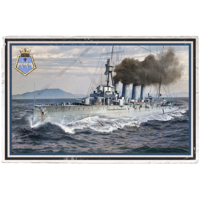
To protect their extensive naval communications during the dreadnought era, the British Empire needed sea-going cruisers that could be built in large numbers. To solve this issue, Town-class cruisers were commissioned by series into the Royal Navy starting from 1910, with each series built under a gradually improving design. Four Weymouth-class protected cruisers belonged to the second series of 1911–1912. A drawback of the preceding Bristol class was eliminated on the Weymouth class by arming the ships with artillery of a unified caliber.
Eight 152 mm guns, arranged according to a rational scheme, demonstrated an overwhelming superiority in terms of a broadside salvo over any of the German "light" cruisers that were built at that time. The next series, named the Chatham class, featured a full-fledged armor belt, which in fact introduced a real light cruiser into the British Navy. The warship, named Weymouth, took active roles in World War I, hunting for German raiders in the Indian Ocean, and fighting against Austro-Hungarian ships in the Adriatic Sea, as well as being a part of the Grand Fleet in the North Sea.
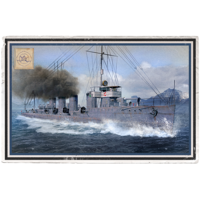
A pair of Umikaze-class destroyers commissioned in 1911 was the starting point for Japan's ascention to the position of a world leader in this type of warship. Developed with the help of British specialists, Umikaze was armed with two 120 mm guns. No other destroyer in the world carried artillery of such great caliber at that time.
For the first time in the Japanese shipbuilding, the ship was equipped with turbines and could run at a speed of 33 knots, which made her not only the fastest, but also the most seakeeping destroyer of the Imperial Navy by the start of World War I. It should be noted, however, that Umikaze did not participate in combat action. In 1930, she was converted into a mine sweeper, and decommissioned six years later.
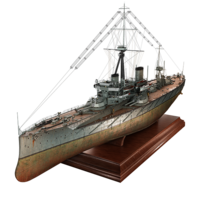
One of the most famous warships in the history of world shipbuilding, and an ancestor to a whole new generation of battleships, Dreadnought appeared because of the determination of the First Sea Lord, Admiral John Fisher, who defined the main elements of the project: artillery consisting of only guns with a large caliber—ten 305 mm guns—and a steam turbine propulsion which allowed for a speed of 21 knots. The project saw both elements being implemented on a capital ship for the first time ever.
The next important factor was the unprecedented work tempo at the shipyards in Portsmouth—officially, it took one year to complete the warship. But Dreadnought also had some flaws. The armor protection was sacrificed to achieve greater fire power and speed, so the ship was inferior to the preceding British fleet ironclads. The 76 mm secondary battery guns she carried turned out to be unable to reliably strike modern destroyers.
But despite those flaws, her arrival had such an impact that the power of rival nation states was determined by the number of battleships of this very class. The commissioning of Dreadnought in December 1906 began a new era of shipbuilding—the era of dreadnoughts—with the ship lending her name to the entire ship type.
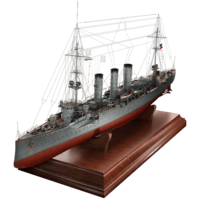
A lead ship in a series of four ships commissioned between 1909 and 1911, Kolberg became a pinnacle of development of "light" armored cruisers in the German Navy. For the first time, all of them were equipped with turbines, and their artillery armament was reinforced by utilizing 12 new 105 mm main guns. However, Kolberg inherited her exterior from the previous epoch—a ram-shaped bow, and an afterdeck.
But the next series of the Magdeburg class of 1912 received a strict and proportional profile of the dreadnought era, and her armor belt, which was quite powerful for this ship type, made these ships the first real German light cruisers. They turned out to be too hard to bite for the 152 mm guns of their British opponents of the Town class. However, the German 105 mm artillery could not damage their enemy counterparts, either.
Over the course of World War I, Kolberg was re-armed with six 150 mm guns. The cruiser fought in the North Sea and Baltic Sea. After the war, she was transferred to France, where served until 1927 under the name of Colmar.
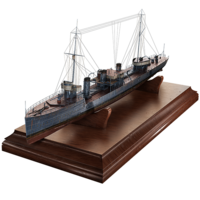
The first of the Russian Navy serial turbine destroyers of the Derzki class were commissioned in 1914 in the Black Sea. The four ships were built under an improved design of Novik that had been inducted into the Baltic Fleet one year earlier, and was an ancestor of a large family of Russian destroyers. Derzki combined powerful torpedo and artillery armament with high speed and sea-going qualities. As of 1914, the destroyer had the greatest number of torpedo tubes—five twin torpedo launchers—though their caliber was a bit less than that of British, American, and German destroyers.
Artillery consisting of three 102 mm guns was comparable to British ships of the same type, but was inferior in terms of caliber to Japanese and Italian ships, and to American ships in their number. But the Russian 102 mm guns surpassed them in terms of rate of fire, shell weight, and firing range. Finally, Derzki was second to none in terms of mine armament—no other destroyer could carry 80 obstacle mines.
The ship took an active role in World War I in the Black Sea by participating in dozens of operations. During the Civil War, the destroyer was interned, after which she became part of the White fleet. From 1920, the ship stayed in French Tunisia, and was sold for scrap in the late 1920s.
Reward
Completing this sub-collection provides the following reward:
![]() +24 hours Warships Premium time
+24 hours Warships Premium time
Ships of World War I
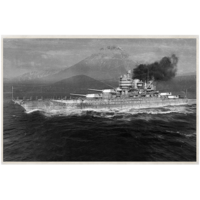
Ships of the New Mexico class that were commissioned between 1917 and 1919 were in fact typical "standard" battleships of the U.S. Navy. Those "standard" features included a modest speed, a main battery with superfiring turrets concentrated in the ship's ends, and an armor pattern that adopted the all-or-nothing approach providing reliable armor protection for the citadel in the central part of the hull.
In 1919, New Mexico escorted President Wilson to the Paris Peace Conference, the same year this all-new battleship became the flag ship of the reorganized Pacific Fleet. In 1923, the same-class battleship Mississippi, for the first time in the history of the U.S. Navy, used a spotting aircraft for firing over very long, once-unthinkable distances. All three battleships took an active part in combat actions in the Pacific until the very end of the war.
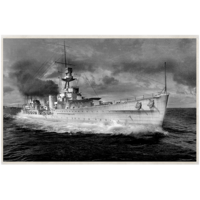
Laid down under the 1916–1918 Emergency War Programs, the Danae-class cruisers materialized the visions of the British Admiralty on what exactly a light cruiser should be like, based on the experience gained during World War I that was at its height at that moment.
At the same time, these ships had many features that were later inherited by the next generations of cruisers, namely high speed, powerful torpedo armament, all main battery guns placed along the centerline, the availability of a spotting aircraft and AA artillery as an obligatory element of the ship's equipment. All eight ships from the series later took part in World War II.
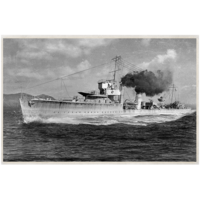
The British W and V-class destroyers, to which HMS Wakeful also belonged, played a significant role in the development of that ship type. The ships were quite large, allowing the allocation of strong on-board armament and powerful propulsion providing high speed.
Additionally, thanks to their comparatively large size, these destroyers could act more freely in the ocean and remain combat-ready in a stormy sea. The experience of World War I showed how important artillery armament was for destroyers. In terms of increased firepower, a big leap forward was made by mounting 120 mm guns onboard the W-class ships of later series. The V and W-class destroyers, which were constructed at the turn of the 1920s, hadn't lost their combat potential and actively performed a variety of missions during World War II two decades later.
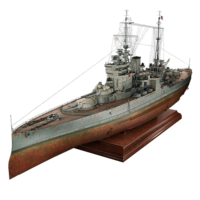
Creation of the Queen Elizabeth-class battleships marked a new stage in the development of military shipbuilding. The 381 mm main battery (the most powerful naval gun at that time), oil-burning boilers and high speed allowed the battleships to be prime examples for all leading naval superpowers.
The lead ship entered service in December, 1914, and three months later, she was already involved in an attack in the Dardanelles. The other four ships of the series became the heroes of the Battle of Jutland in 1916. After a series of upgrades in the 1920s and 30s, the Queen Elizabeth-class battleships turned out to be highly useful in operations during World War II.
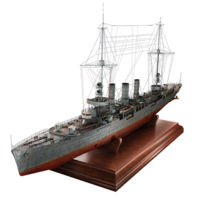
The light cruiser project, which by the will of fate happened to be the pinnacle of development of this type of ship in Imperial Germany, had been designed before World War I broke out. Königsberg, Karlsruhe, Emden, and Nürnberg were launched in the midst of the war. They were named after the German cruisers which had already been destroyed by that time.
Karlsruhe and her sister ships conceded to British light cruisers in speed, but surpassed them in terms of protection and powerful artillery armament. In 1915 and 16, following the first series, ten more almost identical cruisers were laid down.
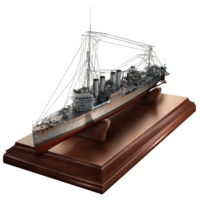
The Clemson-class destroyers were built between 1918 and 1922. The construction series was huge—it accounted for more than 150 ships. Together with the Wickes-class ships, which were called "flush-deckers" or "four-stack" ships, they comprised the base of all light U.S. naval forces up until the second half of the 1930s.
The main advantage of the "flush-deckers" was their overwhelming number. However, each individual ship could pose a real threat due to their high 35-knot speed and powerful torpedo armament comprising twelve 533 mm tubes. The Clemson-class destroyers played an active role in operations in the Pacific and Atlantic Oceans, as well as in Europe, during World War II, despite them being "old-timers" by that point.
Reward
Completing this sub-collection provides the following reward:
![]() +24 hours Warships Premium time
+24 hours Warships Premium time
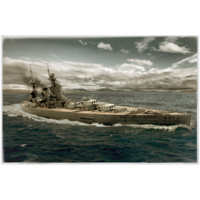
In 1927, the British Royal Navy was joined by possibly the most unusual battleships to grace their fleet—Nelson and Rodney. They stood out among all other warships in the world by the position of their main battery guns.
All three turrets housing 406 mm guns were placed at the bow end. This unusual layout was caused by a drive to reduce the length of the armored citadel, while at the same time, observing the weight limits in accordance with the Washington Naval Treaty of 1922.
Both battleships had served for more than two decades and taken an active part in many World War II operations, including the Normandy landing and the sinking of Bismarck.
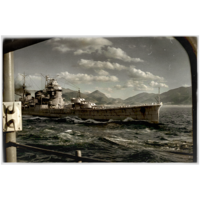
Four Myōkō-class ships entered service in 1928 and 1929, becoming the first conventional "Washington Treaty" cruisers of the Imperial Japanese Navy.
Due to exceeding the maximum standard displacement limits that, needless to say, was kept a secret, the Japanese managed to create fast cruisers with decent armor which combined powerful artillery and torpedo armament.
All four ships of the series underwent several upgrades in the 1930s which further improved their firepower, and were actively used during the war in the Pacific Ocean. Three of them were destroyed in battles.
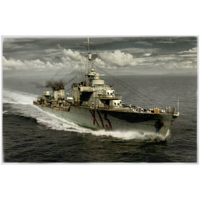
In the mid-1920s, a new ship type appeared in the French Navy—large destroyers ("contre-torpilleurs"). In terms of their characteristics, they occupied an intermediate position between light cruisers and destroyers, and resembled the British destroyer flotilla leaders.
However, unlike the latter, the French contre-torpilleurs were intended primarily for operations as part of homogeneous formations. Typical representatives of this type were the Aigle-class large destroyers, which entered service between 1931 and 1934.
Their distinctive silhouette, 36-knot speed and powerful main battery of five 139 mm guns were the distinguishing features of these half-cruisers, half-destroyers.
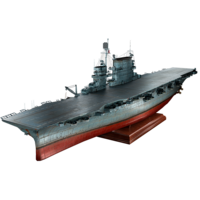
The Lexington-class ships were laid down in 1920 and 1921 as battle cruisers of a very large size that had an extreme speed for their time and unusually powerful armament. However, the conference aimed at the restriction of naval construction held in Washington in 1922 completely changed their destiny.
USS Lexington and USS Saratoga were completed as aircraft carriers—a new ship type that had only started to unlock its true potential. The remaining four cruisers of the series were disassembled on the stocks. Enormous dimensions and high speed became essential advantages of the new ships, which mostly predetermined the formation of a type of strike aircraft carrier during World War II that replaced battleships as key combat units of the navy.
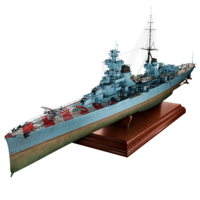
The decisive influence on the development of the cruiser type was exerted by the 1922 Washington Naval Conference. Having fixed the uppermost parameters at 10,000 tons for displacement and 203 mm for artillery caliber, the conference set the threshold limits for cruiser construction the world over.
In the Italian Royal Navy, the first ships of this type built to these standards were Trento and Trieste, which entered service between 1928 and 1929. Through a number of constructive tricks, sacrifices and compromises, the Italians created high-speed ships with impressive armament, but relatively weak armor—a disadvantage typical of the "Washington Treaty" cruisers.
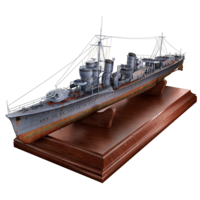
Destroyers of the so-called "special type", the first of which were the ships of the Fubuki class, were built in Japan in several series between 1926 and 1932.
It is no exaggeration to say that, by their appearance, they gave a powerful impetus to the development of this type of ship all over the world. With a high speed of 38 knots, main battery guns arranged in fully enclosed twin mounts, and extremely powerful torpedo armament, the Fubuki-class destroyers were far superior to their predecessors and contemporaries, and could even compete with many light cruisers.
Reward
Completing this sub-collection provides the following reward:
![]() +24 hours Warships Premium time
+24 hours Warships Premium time
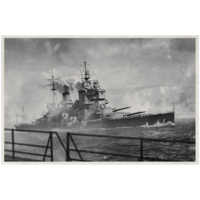
The King George V-class ships were the first British battleships to be designed after the long break of 1922–1936, known as "battleship vacation". They couldn't boast any outstanding tactical or technical elements.
Due to ambiguities of treaty limitations, the 356 mm main battery was selected, which turned out to be weaker than the guns of the new battleships of other countries. Armor protection was not considered sufficient for the necessary protection against 380–406 mm shells. The dual-purpose 133 mm gun mounts, in reality, turned out to be of little use as an AA weapon and the torpedo protection was deemed unsatisfactory. As a result of design errors, the cruising range and seaworthiness left much to be desired.
Nevertheless, battleships of the King George V class were built as a series of five ships—the largest series in the world at the time. They entered service at the right time, at the beginning of World War II. In real combat conditions, the Royal Navy was able to use these battleships so skillfully that they effectively coped with the objective of neutralizing Kriegsmarine surface ships in European waters. It is symbolic that it was the King George V-class ships that played one of the key roles in the sinking of as many as two German battleships—Bismarck and Scharnhorst.
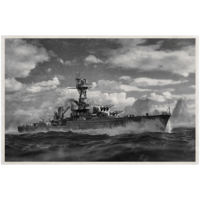
With all performance characteristics combined, the La Galissonnière-class ships laid down between 1931 and 1933 constituted almost ideal pre-war light cruisers. Their armor provided almost absolute protection against projectiles with a caliber of up to 152 mm at striking distances. The three 152 mm triple turrets they carried were characterized as extremely successful and could even be sighted at a target remotely. The 90 mm long-range twin AA guns provided quite a strong defense at the moment when the project was created. The ship carried a strong aircraft complement of up to four seaplanes.
Despite the fact that the main requirement for the project was a sharp increase in protection at the cost of a slight decrease in speed, during trials, La Galissonnière produced a speed of 35 knots. However, the construction of this series of six warships was substantially delayed for various reasons, and the circumstances of World War II deprived them of an opportunity to demonstrate their combat capabilities to their fullest.
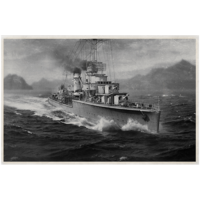
The Type 1934 destroyers, to which Z-1 Leberecht Maass belonged, were the first series of full-fledged ships of this type, designed in Germany even before it denounced the limitations imposed by the Versailles Treaty.
The sixteen destroyers laid down between 1934 and 1935 were created to confront the French contre-torpilleurs. For that purpose, they were equipped with a powerful main battery of five 127 mm guns. The ships' AA defenses and torpedo armament of two quad 533 mm launchers posed a rather serious threat at that time.
The disadvantage of the project turned out to be technically advanced engines driven by steam at high pressures and temperatures which, in reality, turned out to be extremely unreliable. High fuel consumption drastically reduced the operational range. Seaworthiness and maneuverability were also rated as pretty mediocre. However, these were the very ships that formed the backbone of the Kriegsmarine destroyer fleet at the beginning of World War II, with seven of them lost as early as 1940, including Leberecht Maass.
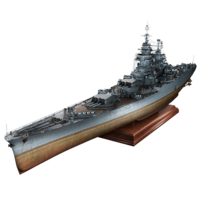
Battleships Richelieu and Jean Bart, laid down between 1935 and 1936, were built to counterbalance the new Italian battleships armed with 381 mm main battery guns. France tried to create a project within the limits of displacement imposed by the Washington Naval Treaty, while using the Dunkerque-class designs as much as possible to speed up the work. This accounts for the ship's 380 mm main battery and general layout that featured both of her quadruple turrets mounted on the bow.
The result was not only the most innovative project of the so-called "treaty battleships", the construction of which began in the second half of the 1930s after a long break, but also one of the most successful and well-balanced projects.
The audacious solutions used for Richelieu proved to be quite justified. The completely new type of boilers yielded great weight savings and gave excellent output, working reliably to provide a speed of 31 knots. The torpedo protection was the best in the world and matched the estimated resistance. The armor protection system, artillery of 380 mm main guns, and 152 mm secondary battery all met the highest requirements.
Perhaps the only weakness was the AA defense system. Richelieu was, of course, inferior in combat strength to American battleships built in the 1940s, but not in terms of armor protection which could be compared to that of Yamato, based on the best quality French armor. Therefore, any World War II battleship would have met a worthy opponent in these French ships, and hardly anyone would have dared predict the outcome of a one-on-one encounter at sea.
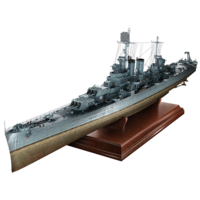
The London Naval Treaty of 1930 set a limit on the number of heavy cruisers that were allowed to be laid down until 1936 for each participating country. After a large series of the New Orleans-class heavy cruisers, the United States had its last slot for 1935. So, they decided to build a one-of-a-kind cruiser, trying to experiment and create a project based on the latest Brooklyn-class light cruisers and replacing 152 mm guns with 203 mm guns.
The hull inherited from the prototype provided better seaworthiness and resistance to damage in combat. The armor thickness was increased, and, in terms of armor protection, Wichita was superior to all previous American cruisers. The main battery guns were placed in new turret mounts and the anti-aircraft armament, consisting of the latest 127 mm AA guns, was mounted in a much more rational way.
The ship entered service in 1939, just before World War II began. The outbreak of war in Europe canceled all contracts and allowed the countries to return to the construction of cruisers armed with 203 mm main battery artillery which had been banned since 1936. And it turned out that there was simply no better prototype than Wichita. The increase in displacement, which was mainly used to strengthen anti-aircraft weapons and ensure better seaworthiness and stability, resulted in the creation of the Baltimore- and Oregon City-class heavy cruisers—the world's best series of heavy cruisers.

Laid down in 1936, the Tribal-class destroyers seemed to the Royal Navy to be too large and expensive while having weak torpedo armament. Therefore, for the next series of these ships, it was decided to return to more balanced torpedo and artillery armament, with a slightly lower displacement. The designers chose three 120 mm twin mounts and two quintuple-tube torpedo launchers.
Eight J-class destroyers, which entered service in 1939, became, in many respects, milestone ships, surpassing even the famous Tribal-class. Until the Battle-class ships were created at the end of the war, practically all subsequent British destroyers were to some extent an upgrade of this successful project. The changes were mainly related to the set of weapons, while the hull and engine remained practically unchanged.
Only two J-class ships survived World War II. Our Jervis is among them.
Reward
Completing this sub-collection provides the following reward:
![]() +24 hours Warships Premium time
+24 hours Warships Premium time
World War II and Postwar Ships
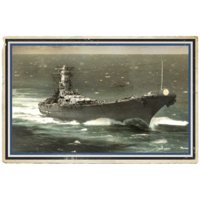
Suffice to say, Yamato and Musashi were the largest warships of World War II and the world's largest battleships. The centerpiece of the project that was created between 1934 and 1936 was the individual qualitative superiority over any battleship of a potential enemy.
The most powerful armor in the history of shipbuilding, nine of the largest 460 mm main battery guns, and a speed of about 28 knots, could be rivalled only by some high-speed battleships, which were definitely inferior in other ways. Despite all the shortcomings of Japanese radar and air defense systems, Yamato's main battery fire control systems were the pinnacle of engineering at that time.
Therefore, when the battleships of this class entered service in December 1941 and August 1942, they were definitely powerful weapons that would be extremely difficult to counter. But each weapon is only as good as he who wields it.
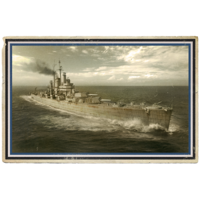
Following the naval battles with Japan in the Pacific in 1942, the U.S. Navy ordered a new rapid-firing 203 mm artillery system. A new triple-gun turret with automatic shell loading was designed for this system and, ultimately, a new hull and a new ship had to be designed to carry it.
This is how the Des Moines-class heavy cruisers were created. Almost similar in their appearance, with the exception of size, to their Oregon City-class predecessors, these ships had a staggering main battery firing rate—90 rounds per minute. The ship's set of AA defenses was altered—Des Moines carried single-caliber AA artillery consisting of twelve twin 76 mm automatic guns.
Only three ships of this class entered service, and one of them—Newport News—became the last artillery cruiser in the U.S. Navy. Having taken part in the hostilities in Vietnam, the ship was decommissioned in 1975.
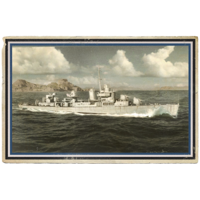
The Fletcher-class destroyers were the result of the war that began in Europe and led to the cancellation of all restrictions on the construction of new ships, primarily those on ships' tonnage. Because of this, additional requirements were immediately implemented, for example, to increase the output of the engine and, for the first time, to equip part of the hull with anti-fragmentation armor.
As early as at the design stage, provision was made for an increase in the ship's displacement in order to mount new weapons systems. Initially, the weapons she carried did not differ much from those carried by her predecessors—five 127 mm guns, two 533 mm quintuple-tube torpedo launchers, one additional AA gun, and four additional anti-submarine mortars.
But, when in the course of hostilities, the need arose to dramatically increase the ship's AA and ASW capabilities, this was easily done without compromising stability or other weapons. Therefore, 175 Fletcher-class destroyers that were launched during the war and commissioned in large numbers since the summer of 1942 became the backbone of the U.S. Navy's destroyer forces in the most difficult and decisive battles of World War II.
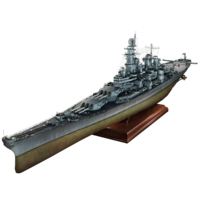
After Japan's refusal to join the 1936 London Naval Treaty, the countries that signed it received the right to increase the displacement of their battleships to 45,000 tons. This allowed the U.S. Navy to engage in the design of a long-desired high-speed battleship, which was previously technically impossible due to its limitations. A new 406 mm main battery gun was specifically developed for the ship, and in 1939, Congress approved the construction of four such battleships at once and two more ships soon afterward.
Initially, the project was conceived as a high-speed variant of the South Dakota-class ships, which had already been laid down, but the hull had to be thoroughly redesigned. In terms of armor and anti-torpedo protection, Iowa was almost similar to her predecessor. The new armament meant her main battery guns turned out to be much more powerful. The dual-purpose guns remained the same as those on the South Dakota-class ships. The small-caliber AA artillery was constantly enhanced during service. The main qualitative change was the speed of 32.5 knots in comparison with 27.5 knots.
The long history of the four Iowa-class battleships that were commissioned and survived is fairly well known. But it is remarkable how quickly these ships were built in wartime, despite all the complexity of this work. Three of the four battleships entered service well ahead of schedule. Wisconsin, which was laid down on January 25, 1941, at the Philadelphia Naval Shipyard, was delivered to the Navy a year and two months ahead of schedule. An amazing result!
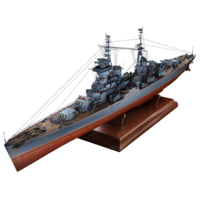
The Project 68-bis light cruisers, which entered service with the Soviet Navy in 1952, became the most numerous, powerful, and perfect representatives of their type ever to be built in the Soviet Union—a total of 14 ships. In many respects, they were on a par with their foreign counterparts that served in the fleets of potential adversaries in the 1950s—Belfast-, Tiger-, Cleveland-, and Worcester-class cruisers.
The advantages of the Sverdlov-class ships include powerful artillery armament, primarily 152 mm main battery guns with good ballistics, excellent turret mounts, and the latest fire control system. The ship's main battery guns could be used even in rough seas up to grade 6 inclusive. The Project 68-bis cruisers owe their longevity to the excellent characteristics of their 152 mm guns, including when firing at shore-based targets. The ships also had good seaworthiness, which they repeatedly demonstrated in a variety of conditions throughout their service, which lasted until the end of the 1980s.
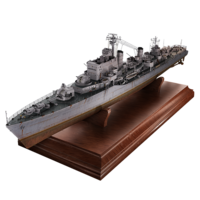
The Halland-class destroyers became the pinnacle of the evolutionary development of the authentic light forces of the Swedish Navy in the first half of the 20th century.
After World War II, Sweden was among the few European countries that had an industry capable of designing and building modern ships of this type. The destroyers were equipped with exclusively Swedish-made machines, mechanisms, combat, radar, and radio systems. Automatic main battery and AA guns with calibers of 120 mm, 57 mm, and 40 mm, and Bofors anti-submarine rocket launchers made Halland almost an exemplary representative of the destroyers of the 1950s. Moreover, during that period, Swedish-made anti-ship missiles were already deployed and tested on the ship. Besides Sweden, only the U.S.S.R. had such weapons at that time.
However, unlike the superpowers, the Scandinavian country didn't have the resources to launch such ships in any significant numbers. Therefore, only two destroyers of this class entered service with the Swedish Navy.
Reward
Completing this sub-collection provides the following reward:
![]() +24 hours Warships Premium time
+24 hours Warships Premium time
Overall Reward
Completing the entire collection provides the following reward:
| Icon | Details | Bonuses |
|---|---|---|

|
Epoch permanent camouflage, attachable to most Tier IX ships. |
|
